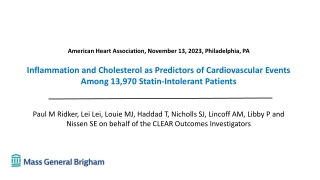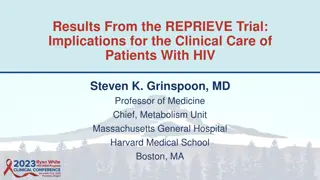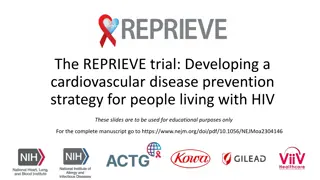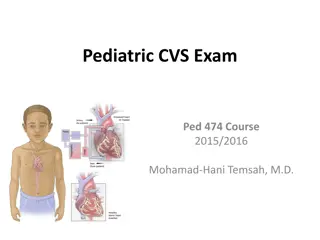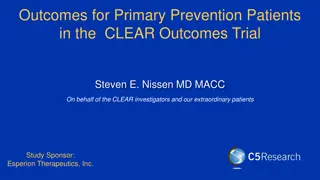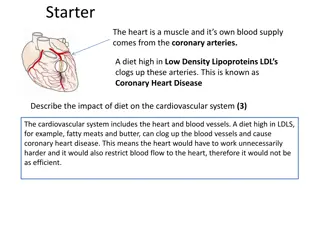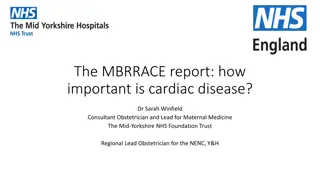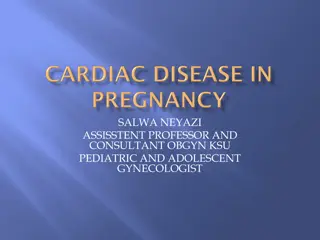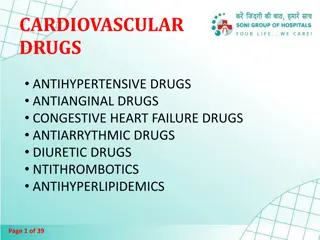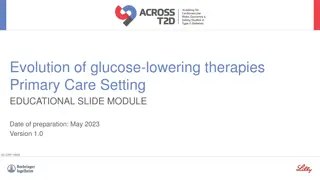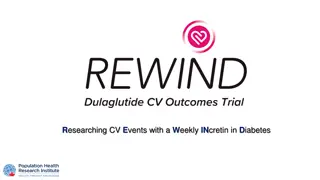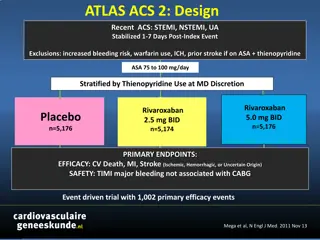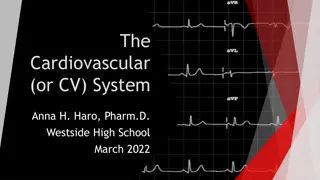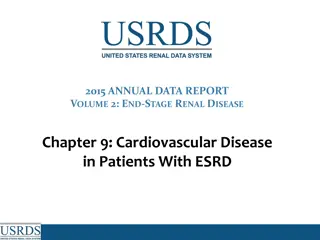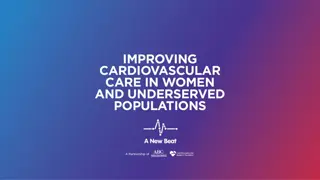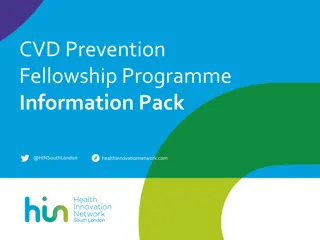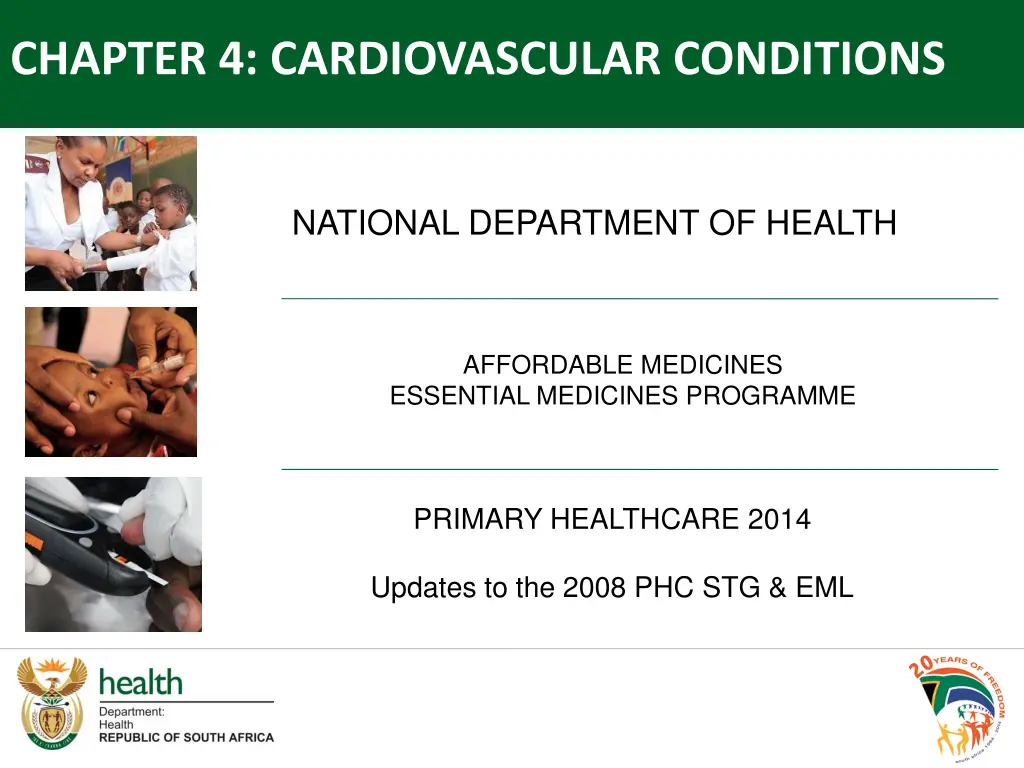
Cardiovascular Conditions Prevention and Treatment Updates
Explore the latest updates in prevention and treatment strategies for cardiovascular conditions, including the importance of baseline lipid measurements and the impact of LDL reduction on clinical outcomes. Learn about the use of tools like Framingham risk score and simvastatin in managing ischaemic heart disease and atherosclerosis.
Download Presentation

Please find below an Image/Link to download the presentation.
The content on the website is provided AS IS for your information and personal use only. It may not be sold, licensed, or shared on other websites without obtaining consent from the author. If you encounter any issues during the download, it is possible that the publisher has removed the file from their server.
You are allowed to download the files provided on this website for personal or commercial use, subject to the condition that they are used lawfully. All files are the property of their respective owners.
The content on the website is provided AS IS for your information and personal use only. It may not be sold, licensed, or shared on other websites without obtaining consent from the author.
E N D
Presentation Transcript
CHAPTER 4: CARDIOVASCULAR CONDITIONS NATIONAL DEPARTMENT OF HEALTH AFFORDABLE MEDICINES ESSENTIAL MEDICINES PROGRAMME PRIMARY HEALTHCARE 2014 Updates to the 2008 PHC STG & EML
4.1 PREVENTION OF ISCHAEMIC HEART DISEASE & ATHEROSCLEROSIS Framingham tables: amended UK Prospective Diabetic Study risk engine: not added Chronic Disease for Africa BMI risk assesment tool: not added Framingham tables aligned with current South African Dyslipidaemia Guidelines, 2012. Rationale: The Framingham risk score is an established validated tool for risk assessment of CVD. UK Prospective Diabetic Study risk engine for specific assessment of CVD in type 2 diabetes mellitus not pragmatic at primary level of care. Level of evidence: III Guidelines Ref 1 PRIMARY HEALTHCARE IMPLEMENTATION SLIDES 2014: CARDIOVASCULAR CONDITIONS 2
4.1 PREVENTION OF ISCHAEMIC HEART DISEASE & ATHEROSCLEROSIS Diagnosis of dyslipidaemia Indication for Lipid Lowering Drug Therapy Baseline measurement of HDL levels: added Rationale: Framingham score requires baseline measurement of HDL, LDL and total cholesterol levels to risk assess a patient (Refer to section 9.2.2 Type 2 diabetes mellitus, adults). A full lipogram at baseline is therefore essential in patients that require a risk calculation. Level of evidence: II RCT Ref 2 PRIMARY HEALTHCARE IMPLEMENTATION SLIDES 2014: CARDIOVASCULAR CONDITIONS 3
4.1 PREVENTION OF ISCHAEMIC HEART DISEASE & ATHEROSCLEROSIS Simvastatin: dose of 10 mg not amended 1. How much of a reduction in LDL translates into a clinical benefit? Trials suggest an approximate linear relationship between LDL cholesterol achieved & coronary mortality. However, evidence is lacking that directly answers the question of optimal LDL targets. (Studies don t provide a breakdown of the incremental clinical benefits achieved by different LDL targets). Ref 3 PRIMARY HEALTHCARE IMPLEMENTATION SLIDES 2014: CARDIOVASCULAR CONDITIONS 4
4.1 PREVENTION OF ISCHAEMIC HEART DISEASE & ATHEROSCLEROSIS Delahoy et al (2009): A metaregression (25 RCTs, n= 155 613 with 23 791 major vascular events) reported significant reduction in the risk of major vascular events associated with a reduction in LDL. Results: For every 25 mg/dL (0.65 mmol/L) reduction in LDL, the proportional reduction, RR (95% CI and r2 statistic), for various cardiovascular events were: vascular mortality, 11% (0.89 [0.87 to 0.92], r2 =0.75); major coronary events, 16% (0.84 [0.82 to 0.86], r2 =0.87); major vascular events,14% (0.86 [0.84 to 0.88], r2 =0.84); and fatal and nonfatal stroke, 10% (0.90 [0.86 to 0.94], r2=0.47). 20 % reduction of major coronary events 23 % reduction of major vascular events 15 % reduction of fatal and nonfatal stroke 16 % reduction of vascular mortality 1.0 mmol/L reduction in LDL These results support the linear relationship between reduction in LDL and reductions in clinical events. Ref 4 PRIMARY HEALTHCARE IMPLEMENTATION SLIDES 2014: CARDIOVASCULAR CONDITIONS 5
4.1 PREVENTION OF ISCHAEMIC HEART DISEASE & ATHEROSCLEROSIS Takagi et al (2013): Used a more sophisticated, quadratic flexible meta-regression model (better fitted the data than the linear model). - Analysed if there is a threshold for the benefit of LDL reduction, achieved with statins; OR - If greater reductions in LDL greater reductions in vascular events. The data showed that there was almost no additional benefit in the use of statins beyond a 40 mg/dL (1.03 mmol/L) decrease in LDL level in preventing major vascular events. Meta-analysis by Takagi et al (2013) was forwarded to Cochrane for comment. Two commentaries mentioned that the methodology was appropriate. Ref 5 PRIMARY HEALTHCARE IMPLEMENTATION SLIDES 2014: CARDIOVASCULAR CONDITIONS 6
4.1 PREVENTION OF ISCHAEMIC HEART DISEASE & ATHEROSCLEROSIS 2. Which statin and at what dose would be the most cost-effective to accomplish this clinical benefit? 1. Naci et al (2013): meta-analysis (n=256,827; 181 RCTs) of the dose- comparative effects of different statins on serum lipid levels, reported that mean reduction of LDL from baseline of simvastatin 10 mg was 26%. 2. Law et al s (2003) meta-analysis: simvastatin 10 mg reduced serum concentration of LDL by 27 % ; an absolute LDL reduction of 1.31 mmol/L (95% CI 1.22 to 1.40). Recommendation: Simvastatin 10 mg, orally, daily for prevention of CVD. Rationale: - Reducing LDL > 1.03 mmol/L no additional benefit in reducing risk of major vascular events. - Simvastatin 10 mg reduces LDL by 1.31 mmol/L. Level of evidence: III Expert opinion Ref 6 PRIMARY HEALTHCARE IMPLEMENTATION SLIDES 2014: CARDIOVASCULAR CONDITIONS 7
4.1 PREVENTION OF ISCHAEMIC HEART DISEASE & ATHEROSCLEROSIS Comparative prices of statins: Simvastatin: Cheapest statin currently available (HP09-2014SD tender). Simvastatin 10 mg less expensive than 20 mg. MEDICINE DOSE EFFECT ON LDL (%) R6.09 R7.00 Atorvastatin 5 mg -28% R6.00 R 4.26 Fluvastatin 40 mg -25% Simvastatin 10 mg (28) R5.00 Lovastatin 20 mg -27% R4.00 Pravastatin 40 mg -34% R3.00 Simvastatin 20 mg (28) Rosuvastatin 5 mg -45% R2.00 Simvastatin 10 mg -30% R1.00 -Delahoy PJ, Magliano DJ, Webb K, Grobler M, Liew D. The relationship between reduction in low-density lipoprotein cholesterol by statins and reduction in risk of cardiovascular outcomes: an updated meta-analysis. ClinTher. 2009 Feb;31(2):236-44. --SAMF, 2012, 10th edition. --Lexi-Comp Drug Information Handbook, 2008-2009, 17th edition. -- Nawrocki JW, Weiss SR, Davidson MH, Sprecher DL, Schwartz SL, Lupien PJ, Jones PH, Haber HE, Black DM. Reduction of LDL cholesterol by 25% to 60% in patients with primary hypercholesterolemia by atorvastatin, a new HMG-CoA reductase inhibitor. Arterioscler Thromb Vasc Biol. 1995 May;15(5):678-82. http://atvb.ahajournals.org/content/15/5/678.long R- Price comparison of simvastatin 10 vs 20 mg PRIMARY HEALTHCARE IMPLEMENTATION SLIDES 2014: CARDIOVASCULAR CONDITIONS 8
4.1 PREVENTION OF ISCHAEMIC HEART DISEASE & ATHEROSCLEROSIS Simvastatin 10 mg: indications amended Indications for statin therapy, irrespective of cholesterol level was expanded as follows: Type 2 diabetics > 40 years of age, or diabetes for > 10 years, or existing cardiovascular disease or chronic kidney disease (eGFR< 60 mL/min). Rationale: Aligned with Adult Hospital level STG, 2012 and South African Dyslipidaemia Guidelines, 2012. Level of evidence: III Guidelines Ref 7 PRIMARY HEALTHCARE IMPLEMENTATION SLIDES 2014: CARDIOVASCULAR CONDITIONS 9
4.1 PREVENTION OF ISCHAEMIC HEART DISEASE & ATHEROSCLEROSIS Simvastatin 10 mg: directions for use amended Simvastatin should be taken at night. Saito et al. (1991) and Wallace et al. (2003) suggest a greater reduction in LDL-C with an evening dose (low quality studies). FDA recommends evening administration for statins with shorter half- lives e.g. simvastatin and, daytime administration for the statins with longer half-live and/or active metabolites e.g. atorvastatin as cholesterol is biosynthesized in the early morning hours Level of evidence: II RCT Ref 8 PRIMARY HEALTHCARE IMPLEMENTATION SLIDES 2014: CARDIOVASCULAR CONDITIONS 10
4.1 PREVENTION OF ISCHAEMIC HEART DISEASE & ATHEROSCLEROSIS Calcification associated with statins Safety data pertaining to calcification of arteries associated with statins was investigated. Underpowered, observational, cohort study (n=167): Frequent use of statins vs. less frequent use associated with accelerated coronary artery calcification (mean SE, 8.2 0.5 mm3 vs. 4.2 1.1 mm3, p < 0.01) in type 2 diabetics. Observational study (n=245) in asymptomatic type 2 Hispanic diabetics: reduction in coronary artery calcification associated with statin use. Recommendation: Statins retained for primary and secondary prevention of cardiovascular events. Rationale: Evidence is conflicting and not adequately robust to change policy. Level of evidence: III Observational studies Ref 9 PRIMARY HEALTHCARE IMPLEMENTATION SLIDES 2014: CARDIOVASCULAR CONDITIONS 11
4.1 PREVENTION OF ISCHAEMIC HEART DISEASE & ATHEROSCLEROSIS Alignment with the United States AHA Guidelines (2013) and treating to target: not added Rationale: Treat to target approach not appropriate or economically viable for public healthcare. Level of evidence: III Expert opinion PRIMARY HEALTHCARE IMPLEMENTATION SLIDES 2014: CARDIOVASCULAR CONDITIONS 12
4.1 PREVENTION OF ISCHAEMIC HEART DISEASE & ATHEROSCLEROSIS Atorvastatin, 10 mg: added Aligned with the Adult Hospital level STG (2013) recommendations for concomitant use of a statin with protease inhibitors: Rationale: Potential for drug-drug interaction with protease inhibitors is possibly greater with simvastatin compared to atorvastatin. Level of evidence: III Guidelines Ref 10 PRIMARY HEALTHCARE IMPLEMENTATION SLIDES 2014: CARDIOVASCULAR CONDITIONS 13
4.2 ANGINA PECTORIS, STABLE Amlodipine: retained Nifedipine XL: deleted Amlodipine is less costly than nifedipine. Gingival hypertrophy is a class effect & reported to be associated with both amlodipine and nifedipine. Level of evidence: II RCT Ref 11 PRIMARY HEALTHCARE IMPLEMENTATION SLIDES 2014: CARDIOVASCULAR CONDITIONS 14
4.3 ANGINA PECTORIS, UNSTABLE / NON ST ELEVATION MYOCARDIAL INFARCTION (NSTEMI) Oxygen: indication for use amended Conclusive evidence from RCTs to support or not support the routine use of inhaled oxygen in patients with acute AMI is lacking. Text was amended, aligning with the Adult Hospital level STG, 2012 as: Oxygen 40% via facemask, if saturation below 92% or if in distress . Level of evidence: III Guidelines Ref 12 PRIMARY HEALTHCARE IMPLEMENTATION SLIDES 2014: CARDIOVASCULAR CONDITIONS 15
4.3 ANGINA PECTORIS, UNSTABLE / NON ST ELEVATION MYOCARDIAL INFARCTION (NSTEMI) Aspirin: dose amended Isosorbide dinitrate: dose not amended The dose of aspirin was aligned with the Adult Hospital level STGs and EML, 2012 edition, from Aspirin soluble, oral, 150 mg immediately to Aspirin soluble, oral, 300mg immediately as a single dose. The dose of isosorbide dinitrate, sublingual, 5 mg was retained as a single dose to ensure that these patients are referred urgently with further management dependant on instructions from the referral institution. Level of evidence: III Guidelines Ref 13 PRIMARY HEALTHCARE IMPLEMENTATION SLIDES 2014: CARDIOVASCULAR CONDITIONS 16
4.3 ANGINA PECTORIS, UNSTABLE / NON ST ELEVATION MYOCARDIAL INFARCTION (NSTEMI) Streptokinase, IV, 1.5 million IU: contra- indications amended The contra-indications were amended to align with the manufacturer s package insert and the Adult STG and EML, 2012 edition. Morphine, IV: directions for use amended Text was aligned with the Adult Hospital level STG, 2012. Level of evidence: III Guidelines Ref 14 PRIMARY HEALTHCARE IMPLEMENTATION SLIDES 2014: CARDIOVASCULAR CONDITIONS 17
4.3 ANGINA PECTORIS, UNSTABLE / NON ST ELEVATION MYOCARDIAL INFARCTION (NSTEMI) eta-blocker: not added This therapeutic agent was not added to the PHC EML, as all suspected or diagnosed cases require referral to secondary level. Level of evidence: III Guidelines PRIMARY HEALTHCARE IMPLEMENTATION SLIDES 2014: CARDIOVASCULAR CONDITIONS 18
4.4 MYOCARDIAL INFARCTION, ACUTE (AMI) / STEMI (ST ELEVATION MYOCARDIAL INFARCT) Emergency treatment: Before transfer Clopidogrel: not added Clopidogrel is a tertiary level medicine. Streptokinase: caution box amended Caution box for streptokinase in this clinical setting, aligned with the British National Formulary (2009) as: CAUTION Blood pressure may decrease and pulse rate may increase after administration of streptokinase. Do not stop streptokinase when there is a drop in blood pressure, but reduce the infusion rate. However, discontinue streptokinase if patient shows manifestations of impending shock. Level of evidence: III Guidelines Ref 15 PRIMARY HEALTHCARE IMPLEMENTATION SLIDES 2014: CARDIOVASCULAR CONDITIONS 19
4.4 MYOCARDIAL INFARCTION, ACUTE (AMI) / STEMI (ST ELEVATION MYOCARDIAL INFARCT) eta-blocker: not added Enalapril: not added Isosorbide mononitrate: not added These therapeutic agents were not added to the PHC EML, as all suspected or diagnosed cases require referral to secondary level. Level of evidence: III Guidelines PRIMARY HEALTHCARE IMPLEMENTATION SLIDES 2014: CARDIOVASCULAR CONDITIONS 20
4.6.1 CARDIAC FAILURE, CONGESTIVE (CCF), ADULTS STG retained in PHC book Rationale: Patients need to be assessed by doctor for initiation or change of treatment. STEP 1: All patients with CCF, unless contraindicated or poorly tolerated Enalapril: dose amended Text amended, as enalapril is available as a scored 5 mg tablet. Enalapril, oral, 2.5 mg 12 hourly up to maximum of 10 mg twice daily . Losartan: not added Angiotensin receptor blockers listed on the secondary level EML, as patients that have a poor response to ACE inhibitors (efficacy or safety concerns) are referred to secondary level for further management. Level of evidence: III Expert Opinion, Guidelines Ref 16 PRIMARY HEALTHCARE IMPLEMENTATION SLIDES 2014: CARDIOVASCULAR CONDITIONS 21
4.6.1 CARDIAC FAILURE, CONGESTIVE (CCF), ADULTS STEP 2 Either Carvedilol: added OR Spironolactone: retained Evidence:There is no available robust head-to-head data comparing carvedilol vs. spironolactone. Epidemiology: Cardiac failure with reduced ejection fraction more common in South Africa. Efficacy & safety: Spironolactone considered likely to be comparable to carvedilol (see page 22). Primary healthcare facilities: There is currently an inequitable distribution of skills, equipment and access to laboratory services amongst primary care facilities across the country. Recommendation: In the stepwise algorithmic approach for management of CCF in adults, step 2 described as addition of either carvedilol OR spironolactone to ACE- inhibitor. Level of evidence: III Expert opinion PRIMARY HEALTHCARE IMPLEMENTATION SLIDES 2014: CARDIOVASCULAR CONDITIONS 22
4.6.1 CARDIAC FAILURE, CONGESTIVE (CCF), ADULTS Efficacy Safety Start low, go slow up-titration of beta-blockers can result in under dosing. Adequate diagnosis and monitoring using ECGs, etc. Contra-indicated in second- or third- degree heart block. 3 key trials (beta-blockers vs. placebo in patients with mild to severely symptomatic heart failure with REF). 2 demonstrated reduction in mortality & hospitalisation. Estimated NNT for 1 year to postpone 1 death 15 to 25 (dependant on severity). Carvedilol Hyperkalaemia associated with spironolactone RALES trial: spironolactone vs placebo resulted in 30% reduction in mortality amongst moderate to severe cardiac failure (reduced left ventricular ejection fraction of 35%). Spironolactone NNT was 9 for 2 years to postpone one death. Ref 17 PRIMARY HEALTHCARE IMPLEMENTATION SLIDES 2014: CARDIOVASCULAR CONDITIONS 23
4.6.1 CARDIAC FAILURE, CONGESTIVE (CCF), ADULTS Spironolactone: directions for use amended Details of the caution, contra-indicating spironolactone in kidney failure was elaborated as Do not use if eGFR < 30 mL/min. Carvedilol: directions for use amended Defaulting patient re-titrated. Following text was added to the STG, aligned with the SAMF (2012): Should treatment be discontinued for longer than 14 days, reinstate therapy as above . Level of evidence: III Guidelines Ref 18 PRIMARY HEALTHCARE IMPLEMENTATION SLIDES 2014: CARDIOVASCULAR CONDITIONS 24
4.6.1 CARDIAC FAILURE, CONGESTIVE (CCF), ADULTS STEP 4: Digoxin: deleted Rationale: High risk of digoxin toxicity, especially in the elderly, patients with poor renal function, patients with low body weight, hypokalaemia. Level of evidence: III Expert opinion Ref 19 PRIMARY HEALTHCARE IMPLEMENTATION SLIDES 2014: CARDIOVASCULAR CONDITIONS 25
4.7.1 HYPERTENSION IN ADULTS BP treatment target in diabetics: amended to < 140/90 mmHg Cochrane review (n=7314), mean follow up 4.5 years, concluded that evidence dose not support BP targets lower than the standard targets in diabetics with hypertension. Recently published Latin American & European guidelines propose a target BP for diabetics of < 140/90 mmHg. Lopez-Jaramillo et al (2014) reported that many clinical trials showed a lack of benefit of reducing BP < 130/80 mmHg, and also the J-shaped relationship in diabetic mellitus patients. Rationale: Evidence dose not support BP targets lower than the standard targets in diabetics with hypertension. Level of evidence: I Systematic review Ref 20 PRIMARY HEALTHCARE IMPLEMENTATION SLIDES 2014: CARDIOVASCULAR CONDITIONS 26
4.7.1 HYPERTENSION IN ADULTS Medicine treatment choices without compelling indications The stages of hypertension were more clearly defined in the text. An additional category of severe asymptomatic hypertension was included in the STG; aligned with the Adult Hospital level STGs and EML, 2012 edition and South African Hypertension Guidelines, 2011. Level of evidence: III Guidelines Ref 21 PRIMARY HEALTHCARE IMPLEMENTATION SLIDES 2014: CARDIOVASCULAR CONDITIONS 27
4.7.1 HYPERTENSION IN ADULTS Atenolol: retained Treatment with atenolol retained in the STG for patients that failed step 4, after 1 month of compliance; aligned with the Adult Hospital level STGs and EML, 2012 edition and South African Hypertension Guidelines, 2011. Potassium chloride: not added Alpha blocker: not added Alpha blockers are not included in the PHC EML. Prostatism is managed at secondary level facilities. Level of evidence: III Guidelines Ref 22 PRIMARY HEALTHCARE IMPLEMENTATION SLIDES 2014: CARDIOVASCULAR CONDITIONS 28
4.7.2 HYPERTENSION IN CHILDREN Diagnosis Blood Pressure levels for boys and girls by age and height percentile The text was amended for correctness as follows: 95th BP percentiles for boys (mmHg) 103/56 109/65 112/72 114/74 116/78 118/79 119/80 121/80 123/81 95th BP percentiles for girls ( mmHg) 104/58 107/67 110/72 111/74 115/76 117/77 119/78 121/79 123/80 Age ( years ) 1 3 5 6 8 9 10 11 12 Adapted from U.S Department of Health and Human Services. National Institutes of Health (National Heart, Lung, and Blood Institute). The 4th report on the diagnosis, evaluation, and treatment of high blood pressure in children and adolescents, May 2005, using the 50th height percentile. PRIMARY HEALTHCARE IMPLEMENTATION SLIDES 2014: CARDIOVASCULAR CONDITIONS 29
4.9 RHEUMATIC FEVER, ACUTE Eradication of streptococci in throat Amoxicillin, oral: not added Benzathine benzylpenicillin IM: retained as 1st line option Phenoxymethylpenicillin, oral: retained as 2nd line option Most international guidelines recommend benzathine benzylpenicillin IM / oral phenoxymethyl-penicillin as first line options, for eradication of streptococcal tonsillopharyngitis. Efficacy: A Cochrane review (and 2013 update): evidence is insufficient for clinically meaningful differences between antibiotics (penicillin, cephalosporins, macrolides, carbacephem and sulfonamides) for group A beta-hemolytic streptococcal (GABHS) tonsillopharyngitis. Penicillin can still be recommended as first choice, considering the low price and absence of resistance RCT,: 353 children randomised to treat GABHS pharyngitis with amoxicillin (n=177) or penicillin V (n=176) showed that once-daily oral amoxicillin was not inferior to twice-daily penicillin V. Ref 23 PRIMARY HEALTHCARE IMPLEMENTATION SLIDES 2014: CARDIOVASCULAR CONDITIONS 30
4.9 RHEUMATIC FEVER, ACUTE Phenoxymethylpenicillin, oral: amended Dose of phenoxymethylpenicillin was aligned to be consistent with the Paediatric STG, 2013 (Section 4.4 Rheumatic fever, acute). Phenoxymethylpenicillin, oral, 12 hourly for 10 days. - Children under 30 kg: 250 mg - Children over 30 kg and adults: 500 mg Level of evidence: III Guidelines Ref 24 PRIMARY HEALTHCARE IMPLEMENTATION SLIDES 2014: CARDIOVASCULAR CONDITIONS 31
4.9 RHEUMATIC FEVER, ACUTE Penicillin allergy (adults) Erythromycin, oral, (adults): deleted Azithromycin, oral, (adults):added Cardio-toxicity of macrolides: QT prolongation considered a class effect. Available evidence of poor quality: erythromycin & clarithromycin, and to a much lesser extent azithromycin (azalides), can cause prolongation of the QT interval in a dose dependent manner. American Heart Association guidelines for rheumatic fever (2009) recommend macrolides or azalide for eradication of group A-haemolytic streptococcal tonsillopharyngitis or secondary prophylaxis in penicillin allergy; mentions that azithromycin has less risk of QT prolongation. Available evidence shows no difference between macrolides vs penicillin for eradicating group A beta-haemolytic streptococci. Rationale: Adult patients allergic to penicillin represents a small proportion of the population. Azithromycin tablets are better tolerated than erythromycin tablets; would produce better patient adherence; is available on contract. Level of Evidence: III Expert Opinion Ref 25 PRIMARY HEALTHCARE IMPLEMENTATION SLIDES 2014: CARDIOVASCULAR CONDITIONS 32
4.9 RHEUMATIC FEVER, ACUTE Dose of azithromycin, oral (adults): 1. Eradication of streptococci in throat Azithromycin, oral (adults): 500 mg daily for 3 days Level of Evidence: I Meta-analysis 2. Prophylaxis for rheumatic fever Azithromycin, oral (adults): 250 mg daily Paucity of evidence for azithromycin in this clinical setting (Expert consensus obtained; including Rheumatic Fever National Advisory). Erythromycin tablets no longer available on tender: azithromycin 250 mg daily considered. Cardiac safety with long-term use (12 months) of azithromycin 250 mg, daily shown in 2 RCTs (for prevention of exacerbations of COPD and maintenance treatment for non-cystic fibrosis bronchiectasis). There are no available RCTs for daily azithromycin as rheumatic fever prophylaxis. Small RCT: weekly azithromycin vs. phenoxymethyl penicillin 250 mg twice daily found weekly dose of azithromycin to be ineffective in preventing streptococcal throat infection compared to oral penicillin therapy in adult patients with established rheumatic heart disease. Level of Evidence: III Expert Opinion Ref 26 PRIMARY HEALTHCARE IMPLEMENTATION SLIDES 2014: CARDIOVASCULAR CONDITIONS 33
4.9 RHEUMATIC FEVER, ACUTE Prophylaxis for rheumatic fever Period of antibiotic prophylaxis therapy: amended The period of prophylaxis therapy was further amended to align with WHO Guidelines for rheumatic heart disease (2008) and the American Heart Association Guidelines for the prevention of rheumatic fever (2009). All patients with confirmed rheumatic fever and no persistent rheumatic valvular disease: Treat for 10 years or until the age of 21 years, whichever is longer. All patients with confirmed rheumatic fever and persistent rheumatic valvular disease: Treat life long. Level of evidence: III Guidelines Ref 27 PRIMARY HEALTHCARE IMPLEMENTATION SLIDES 2014: CARDIOVASCULAR CONDITIONS 34
4.9 RHEUMATIC FEVER, ACUTE Benzathine benzylpenicillin IM: retained as 1st line option Phenoxymethylpenicillin, oral: retained as 2nd line option Benzathine benzylpenicillin IM, is the preferred treatment; as a 10 day oral antibiotic course may raise adherence issues. Efficacy: A Cochrane reviewof 9 studies (n=3008): penicillin IM seemed to be more effective vs. oral penicillin in preventing rheumatic fever recurrence and streptococcal throat infections. Two-weekly or 3-weekly injections appeared to be more effective than 4-weekly injections. However, the evidence was based on poor quality trials and the data were not pooled because of heterogeneity between studies. Rationale: Evidence of benefit and patient adherence concerns. Level of evidence: II Poor quality RCTs Ref 27 PRIMARY HEALTHCARE IMPLEMENTATION SLIDES 2014: CARDIOVASCULAR CONDITIONS 35
4.9 RHEUMATIC FEVER, ACUTE Lidocaine 1%: added as a diluent for benzathine benzylpenicillin administration Amir et al s (1998) investigation of benzathine benzylpenicillin 1.2 MU diluted with 3.2 mL of WFI vs. 3.2 mL of lidocaine 1% for rheumatic fever concluded that lidocaine 1% does not alter penicillin concentrations in body fluids & reduces the pain of the injection. Level of evidence: III Disease oriented evidence Ref 28 PRIMARY HEALTHCARE IMPLEMENTATION SLIDES 2014: CARDIOVASCULAR CONDITIONS 36
4.10 VALVULAR HEART DISEASE AND CONGENITAL STRUCTURAL HEART DISEASE Amoxicillin: retained Evidence is inconclusive pertaining to the benefit of antibiotic prophylaxis for patients with infective endocarditis undergoing dental treatment (extraction). Available evidence not generalisable to the South African context where prevalence of rheumatic heart conditions reported to be high and public dental services of poor quality. The risk of single dose amoxicillin prior to surgery was considered to be minimal. Level of evidence: III Guidelines & Expert opinion Ref 29 PRIMARY HEALTHCARE IMPLEMENTATION SLIDES 2014: CARDIOVASCULAR CONDITIONS 37
CASE STUDY A 38 year old diabetic male, smoker presents at the clinic. He is currently being reviewed for hypertension treatment. His fasting lipid profile is: Total Cholesterol 6.8mmol/L LDL 4.4mmol/L HDL 1.1 mmol/L Triglycerides 3.3mmol/L Despite appropriate modifications to diet, alcohol intake and exercise, his BP remains high after repeated measurements (over 8 weeks). Patient is not taking any other medication. What actions should be taken? Select all that apply: 1. Counseling on smoking. 2. Initiate antihypertensive treatment. 3. Atorvastatin 10mg in the evening. 4. Simvastatin 10mg in the morning. 5. Simvastatin 10mg in the evening. PRIMARY HEALTHCARE IMPLEMENTATION SLIDES 2014: CARDIOVASCULAR CONDITIONS 38
SOLUTION: CASE STUDY Select all that apply: 1. Counselling on smoking 2. Initiate antihypertensive treatment 3. Atorvastatin 10mg in the evening 4. Simvastatin 10mg in the morning 5. Simvastatin 10mg in the evening Note: Patient s TC > 5 mmol/L, LDL > 3 mmol/L and HDL < 1/1 mmol/L. Major risk factor is smoking and BP has been raised for 8 weeks (at least 3 BP readings should have been taken to diagnose hypertension). Simvastatin is first line treatment for dyslipidaemia - dosed at night (to follow the natural circadian rhythm of cholesterol production). Atorvastatin, oral, 10 mg once daily in the evening is only indicated for patients on Protease Inhibitors. PRIMARY HEALTHCARE IMPLEMENTATION SLIDES 2014: CARDIOVASCULAR CONDITIONS 39
Slide Ref # Reference 4.1 PREVENTION OF ISCHAEMIC HEART DISEASE & ATHEROSCLEROSIS 3 1 FRAMINGHAM TABLES Klug E; South African Heart Association (S A Heart); Lipid and Atherosclerosis Society of Southern Africa (LASSA). South African dyslipidaemia guideline consensus statement. SAMJ 2012 Feb 23;102(3 Pt 2):178-87 SAHA. Update on changes to South African Dyslipidaemia Guidelines, 2012. Available at: http://www.saheart.org/uploads/files/Algorithm2.pdf UK Prospective Diabetic Study risk engine, 2007. Available at: https://www.dtu.ox.ac.uk/riskengine/ Coleman RL, Stevens RJ, Retnakaran R, Holman RR. Framingham, SCORE, and DECODE risk equations do not provide reliable cardiovascular risk estimates in type 2 diabetes. Diabetes Care. 2007 May;30(5):1292-3. Gaziano TA, Pandya A, Steyn K, Levitt N, Mollentze W, Joubert G, Walsh CM, Motala AA, Kruger A, Schutte AE, Naidoo DP, Prakaschandra DR, Laubscher R. Comparative assessment of absolute cardiovascular disease risk characterization from non-laboratory-based risk assessment in South African populations. BMC Med. 2013 Jul 24;11:170. Gaziano TA, Young CR, Fitzmaurice G, Atwood S, Gaziano JM. Laboratory-based versus non-laboratory-based method f orassessment of cardiovascular disease risk: the NHANES IFollow-up Study cohort. Lancet 2008; 371: 923 31. 4 2 FRAMINGHAM TABLES Wilson PW, D'Agostino RB, Levy D, Belanger AM, Silbershatz H, Kannel WB.Prediction of coronary heart disease using risk factor categories. Circulation.1998 May 12;97(18):1837-47. 5 3 SIMVASTATIN Verschuren WM, Jacobs DR, Bloemberg BP, et al. Serum total cholesterol and long-term coronary heart disease mortality in different cultures. Twenty-five year follow-up of the seven countries study. JAMA.1995;274:131 6. Padwal R, Straus SE, McAlister FA. Cardiovascular risk factors and their impact on the decision to treat hypertension: an evidence-based review. BMJ.2001;322:977 80. Baigent C, Keech A, Kearney PM, Blackwell L, Buck G, Pollicino C, Kirby A,Sourjina T, Peto R, Collins R, Simes R; Cholesterol Treatment Trialists' (CTT)Collaborators. Efficacy and safety of cholesterol-lowering treatment: prospective meta-analysis of data from 90,056 participants in 14 randomised trials of statins. Lancet. 2005 Oct 8;366(9493):1267-78. 6 4 SIMVASTATIN Delahoy PJ, Magliano DJ, Webb K, Grobler M, Liew D. The relationship between reduction in low-density lipoprotein cholesterol by statins and reduction in risk of cardiovascular outcomes: an updated meta-analysis. ClinTher. 2009 Feb;31(2):236-44. 7 5 SIMVASTATIN Takagi H, Umemoto T; for the ALICE (All-Literature Investigation of Cardiovascular Evidence) Group. Limit to Benefits of Large Reductions in Low-Density Lipoprotein Cholesterol Levels: Use of Fractional Polynomials to Assess the Effect of Low-Density Lipoprotein Cholesterol Level Reduction in Metaregression of Large Statin Randomized Trials. JAMA Intern Med. 2013 Apr 29:1-2. Cochrane centre: E-mail correspondence of 21January2014. PRIMARY HEALTHCARE IMPLEMENTATION SLIDES 2014: CARDIOVASCULAR CONDITIONS 40
Slide Ref # Reference 4.1 PREVENTION OF ISCHAEMIC HEART DISEASE & ATHEROSCLEROSIS 8 6 SIMVASTATIN Naci H, Brugts JJ, Fleurence R, Ades A. Dose-comparative effects of different statins on serum lipid levels: a network meta-analysis of 256,827 individuals in 181 randomized controlled trials. Eur J Prev Cardiol. 2013 Mar 25. [Epub ahead of print] PubMed PMID: 23529608. Law MR, Wald NJ, Rudnicka AR. Quantifying effect of statins on low density lipoprotein cholesterol, ischaemic heart disease, and stroke: systematic review and meta-analysis. BMJ. 2003 Jun 28;326(7404):1423. 10 7 INDICATION FOR LIPID LOWERING MEDICINE Klug E; South African Heart Association (S A Heart); Lipid and Atherosclerosis Society of Southern Africa (LASSA). South African dyslipidaemia guideline consensus statement. SAMJ 2012 Feb 23;102(3 Pt 2):178-87 SAHA. Update on changes to South African Dyslipidaemia Guidelines, 2012. Available at: http://www.saheart.org/uploads/files/Algorithm2.pdf Adult Hospital level STG, 2012. 11 8 SIMVASTATIN Saito Y, Yoshida S, Nakaya N, Hata Y, Goto Y. Comparison between morning and evening doses of simvastatin in hyperlipidemic subjects. A double-blind comparative study. Arterioscler Thromb. 1991 Jul-Aug;11(4):816-26. Wallace A, Chinn D, Rubin G. Taking simvastatin in the morning compared with in the evening: randomised controlled trial. BMJ. 2003 Oct 4;327(7418):788. 12 9 SIMVASTATIN Saremi A, Bahn G, Reaven PD; VADT Investigators. Progression of vascular calcification is increased with statin use in the Veterans Affairs Diabetes Trial(VADT). Diabetes Care. 2012 Nov;35(11):2390-2. Reaven PD, Sacks J; Investigators for the Veterans Affairs Cooperative Study of Glycemic Control and Complications in Diabetes Mellitus Type 2. Reduced coronary artery and abdominal aortic calcification in Hispanics with type 2 diabetes. Diabetes Care. 2004 May;27(5):1115-20. 14 10 ATORVASTATIN Adult Hospital level STG, 2012. 4.2 ANGINA PECTORIS, STABLE 15 11 AMLODIPINE Ellis JS, Seymour RA, Steele JG, Robertson P, Butler TJ, Thomason JM. Prevalence of gingival overgrowth induced by calcium channel blockers: a community-based study. J Periodontol. 1999 Jan;70(1):63-7. 4.3 ANGINA PECTORIS, UNSTABLE / NON ST ELEVATION MYOCARDIAL INFARCTION (NSTEMI) 16 12 OXYGEN Cabello JB, Burls A, Emparanza JI, Bayliss S, Quinn T. Oxygen therapy for acute myocardial infarction. Cochrane Database of Systematic Reviews 2010, Issue 6. Art. No.: CD007160. 17 13 ASPIRIN Adult Hospital level STG, 2012. 18 14 MORPHINE and STREPTOKINASE Adult Hospital level STG, 2012. 41
Slide Ref # Reference 4.1 PREVENTION OF ISCHAEMIC HEART DISEASE & ATHEROSCLEROSIS 4.4 MYOCARDIAL INFARCTION, ACUTE (AMI) / STEMI (ST ELEVATION MYOCARDIAL INFARCT) 20 15 STREPTOKINASE Tertiary and quaternary level EML, 2013. BNF Guidelines, 2009. 4.6.1 CARDIAC FAILURE, CONGESTIVE (CCF), ADULTS 22 16 ENALAPRIL Adult Hospital level STG, 2012. 4.6.1 CARDIAC FAILURE, CONGESTIVE (CCF), ADULTS 24 17 CARVEDILOL The Cardiac Insufficiency Bisoprolol Study II (CIBIS-II): a randomised trial. Lancet 1999;353:9 13. Effect of metoprolol CR/XL in chronic heart failure: Metoprolol CR/XL Randomised Intervention Trial in Congestive Heart Failure (MERIT-HF). Lancet 1999; 353:2001-2007. Hjalmarson A, Goldstein S, Fagerberg B, Wedel H, Waagstein F, Kjekshus J, Wikstrand J, El Allaf D, Vitovec J, Aldershvile J, Halinen M, Dietz R, Neuhaus KL, Janosi A, Thorgeirsson G, Dunselman PH, Gullestad L, Kuch J, Herlitz J, Rickenbacher P, Ball S, Gottlieb S, Deedwania P. Effects of controlled-release metoprolol on total mortality, hospitalizations, and well-being in patients with heart failure: the Metoprolol CR/XL Randomized Intervention Trial in congestive heart failure (MERIT-HF). MERIT-HF Study Group. JAMA 2000;283:1295 1302. Packer M, Coats AJ, Fowler MB, Katus HA, Krum H, Mohacsi P, Rouleau JL, Tendera M, Castaigne A, Roecker EB, Schultz MK, DeMets DL. Effect of carvedilol on survival in severe chronic heart failure. N Engl J Med 2001;344: 1651 1658. Packer M, Fowler MB, Roecker EB, Coats AJ, Katus HA, Krum H, Mohacsi P, Rouleau JL, Tendera M, Staiger C, Holcslaw TL, Amann-Zalan I, DeMets DL. Effect of carvedilol on the morbidity of patients with severe chronic heart failure: results of the carvedilol prospective randomized cumulative survival (COPERNICUS) study. Circulation 2002;106:2194 2199. SPIRONOLACTONE Pitt B, Zannad F, Remme WJ, Cody R, Castaigne A, Perez A, Palensky J, Wittes J. The effect of spironolactone on morbidity and mortality in patients with severe heart failure. Randomized Aldactone Evaluation Study Investigators. N Engl J Med 1999;341:709 717 25 18 CARVEDILOL and SPIRONOLACTONE SAMF, 10th edition, 2012. 26 19 DIGOXIN Opie LH. Dilated cardiomyopathy and potentially deadly digoxin. SAMJ 2011 May 25;101(6):388, 390. PRIMARY HEALTHCARE IMPLEMENTATION SLIDES 2014: CARDIOVASCULAR CONDITIONS 42
Slide Ref # Reference 4.7.1 HYPERTENSION IN ADULTS 27 20 TARGET BP IN DIABETES MELLITUS Arguedas JA, Leiva V,Wright JM. Blood pressure targets for hypertension in people with diabetes mellitus. Cochrane Database of Systematic Reviews 2013, Issue 10. Art. No.: CD008277. Lopez-Jaramillo P, Sanchez R, Diaz M, Cobos L, Bryce A, Parra-Carrillo JZ, Lizcano F, Lanas F, Sinay I, Sierra IV, Penaherrera E, Bendersky M, Schmid H, Botero R, Urina M, Lara J, Foss MC, Matquez G, Harrap S, Ramorez AJ, Zanchetti A, on behalf of the Latin America expert Group: Latin American consensus on hypertension in patients with diabetes type 2 and metabolic syndrome. J Hypertens 2013, 31:223 238. Mancia G, Fagard R, Narkiewicz K, Redon J, Zanchetti A, Bohm M, Christiaens T, Cifkvra R, De Backer G, Dominiczak A, Galdereisi M, Grobbeee DE, Jaarsma T, Kirchhof P, Kjeldsen SE, Laurent S, Manolis AJ, Nilsson PM, Ruilope LM, Schmieder RE, Sirnes PA, Sleight P, Viigimaa M, Waeber B, Zannad F: ESH/ESC Guidelines for the management of arterial hypertension; The Task Force for the management of arterial hypertension of the European Society of Hypertension (ESH) and of the European Society of Cardiology (ESC). J Hypertens 2013 (31):1281 1357. Lopez-Jaramillo P, Lopez-Lopez J, Lopez-Lopez C, Rodriguez-Alvarez MI. The goal of blood pressure in the hypertensive patient with diabetes is defined: now the challenge is go from recommendations to practice. Diabetol Metab Syndr. 2014 Mar 4;6(1):31. 28 21 ASYMPTOMATIC SEVERE HYPERTENSION Adult Hospital level STG, 2012 Seedat YK, Rayner BL; Southern African Hypertension Society. South African hypertension guideline 2011. S Afr Med J. 2011 Dec 14;102(1 Pt 2):57-83. Erratum in: S Afr Med J. 2012 Feb;102(2):94. 29 22 ASYMPTOMATIC SEVERE HYPERTENSION Adult Hospital level STG, 2012 Seedat YK, Rayner BL; Southern African Hypertension Society. South African hypertension guideline 2011. S Afr Med J. 2011 Dec 14;102(1 Pt 2):57-83. Erratum in: S Afr Med J. 2012 Feb;102(2):94. PRIMARY HEALTHCARE IMPLEMENTATION SLIDES 2014: CARDIOVASCULAR CONDITIONS 43
Slide Ref # Reference 4.9 RHEUMATIC FEVER, ACUTE 31 23 PHENOXYMETHYLPENICILLIN RHD Australia (ARF/RHD writing group), National Heart Foundation of Australia and the Cardiac Society of Australia and New Zealand. Australian guideline for prevention, diagnosis and management of acute rheumatic fever and rheumatic heart disease (2nd edition). 2012 Gerber MA, Baltimore RS, Eaton CB, Gewitz M, Rowley AH, Shulman ST, Taubert KA. Prevention of rheumatic fever and diagnosis and treatment of acute Streptococcal pharyngitis: a scientific statement from the American Heart Association Rheumatic Fever, Endocarditis, and Kawasaki Disease Committee of the Council on Cardiovascular Disease in the Young, the Interdisciplinary Council on Functional Genomics and Translational Biology, and the Interdisciplinary Council on Quality of Care and Outcomes Research: endorsed by the American Academy of Pediatrics. Circulation. 2009 Mar 24;119(11):1541-51. Working Group on Pediatric Acute Rheumatic Fever and Cardiology Chapter of Indian Academy of Pediatrics, Saxena A, Kumar RK, Gera RP, Radhakrishnan S, Mishra S, Ahmed Z. Consensus guidelines on pediatric acute rheumatic fever and rheumatic heart disease. Indian Pediatr. 2008 Jul;45(7):565-73. van Driel ML, De Sutter AI, Keber N, Habraken H, Christiaens T. Different antibiotic treatments for group A streptococcal pharyngitis. Cochrane Database Syst Rev. 2013 Apr 30;4:CD004406. Lennon DR, Farrell E, Martin DR, Stewart JM. Once-daily amoxicillin versus twice-daily penicillin V in group A beta-haemolytic streptococcal pharyngitis. Arch Dis Child. 2008 Jun;93(6):474-8. 32 24 PHENOXYMETHYLPENICILLIN Paediatric Hospital level STG, 2013 33 25 AZITHROMYCIN Guo D, Cai Y, Chai D, Liang B, Bai N, Wang R. The cardiotoxicity of macrolides: a systematic review. Pharmazie. 2010 Sep;65(9):631-40. Review. SAMF, 10th edition, 2012. Contract circular HP02-2013AI, to 31July2015. 34 26 AZITHROMYCIN van Driel ML, De Sutter AI, Keber N, Habraken H, Christiaens T. Different antibiotic treatments for group A streptococcal pharyngitis. Cochrane Database Syst Rev. 2013 Apr 30;4:CD004406. Albert RK, Connett J, Bailey WC, Casaburi R, Cooper JA Jr, Criner GJ, Curtis JL, Dransfield MT, Han MK, Lazarus SC, Make B, Marchetti N, Martinez FJ, Madinger NE, McEvoy C, Niewoehner DE, Porsasz J, Price CS, Reilly J, Scanlon PD, Sciurba FC, Scharf SM, Washko GR, Woodruff PG, Anthonisen NR; COPD Clinical Research Network. Azithromycin for prevention of exacerbations of COPD. N Engl J Med. 2011 Aug 25;365(8):689-98. doi: 10.1056/NEJMoa1104623. Erratum in: N Engl J Med. 2012 Apr 5;366(14):1356. Altenburg J, de Graaff CS, Stienstra Y, Sloos JH, van Haren EH, Koppers RJ, van der Werf TS, Boersma WG. Effect of azithromycin maintenance treatment on infectious exacerbations among patients with non-cystic fibrosis bronchiectasis: the BAT randomized controlled trial. JAMA. 2013 Mar 27;309(12):1251-9. SAMF,10th edition,2012. Gopal R, Harikrishnan S, Sivasankaran S, Ajithkumar VK, Titus T, Tharakan JM. Once weekly azithromycin in secondary prevention of rheumatic fever. Indian Heart J. 2012 Jan-Feb;64(1):12-5. 44
Slide Ref # Reference 4.9 RHEUMATIC FEVER, ACUTE 35 27 PERIOD OF ANTIBITIC PROPHYLAXIS Begs S, Petrson G, Thompson A. Report for the 2ndmeeting of the World Health Organization s subcommittee of the Expert Committee of the selection and use of essential medicines: Antibiotic use for the prevention and treatment of rheumatic fever and treatment of rheumatic fever and rheumatic heart disease in children. 30 June 2008. Gerber MA, Baltimore RS, Eaton CB, Gewitz M, Rowley AH, Shulman ST, Taubert KA. Prevention of rheumatic fever and diagnosis and treatment of acute Streptococcal pharyngitis: a scientific statement from the American Heart Association Rheumatic Fever, Endocarditis, and Kawasaki Disease Committee of the Council on Cardiovascular Disease in the Young, the Interdisciplinary Council on Functional Genomics and Translational Biology, and the Interdisciplinary Council on Quality of Care and Outcomes Research: endorsed by the American Academy of Pediatrics. Circulation. 2009 Mar 24;119(11):1541-51. 36 27 PHENOXYMETHYLPENICILLIN and BENZATHINE BENZYLPENICILLIN Denny FW, Wannamaker LW, Brink WR, Rammelkamp CH Jr, Custer EA. Prevention of rheumatic fever: treatment of the preceding streptococcic infection. J Am Med Assoc. 1950;143:151 153. Wannamaker LW, Rammelkamp CH Jr, Denny FW, Brink WR, Houser HB, Hahn EO, Dingle JH. Prophylaxis of acute rheumatic fever by treatment of preceding streptococcal infection with various amounts of depot penicillin. Am J Med. 1951;10:673 695. [The above are cited in Gerber MA, et al. Prevention of rheumatic fever and diagnosis and treatment of acute Streptococcal pharyngitis: a scientific statement from the American Heart Association Rheumatic Fever, Endocarditis, and Kawasaki Disease Committee of the Council on Cardiovascular Disease in the Young, the Interdisciplinary Council on Functional Genomics and Translational Biology, and the Interdisciplinary Council on Quality of Care and Outcomes Research: endorsed by the American Academy of Pediatrics. Circulation. 2009 Mar 24;119(11):1541- 51]. Manyemba J, Mayosi BM. Penicillin for secondary prevention of rheumatic fever. Cochrane Database Syst Rev. 2002;(3):CD002227. 37 28 Amir J, Ginat S, Cohen YH, Marcus TE, Keller N, Varsano I. Lidocaine as a diluent for administration of benzathine penicillin G. Pediatr Infect Dis J. 1998 Oct;17(10):890-3. 4.10 VALVULAR HEART DISEASE AND CONGENITAL STRUCTURAL HEART DISEASE 38 29 AMOXICILLIN Glenny AM, Oliver R, Roberts GJ, Hooper L, Worthington HV. Antibiotics for the prophylaxis of bacterial endocarditis in dentistry. Cochrane Database Syst Rev. 2013 Oct 9;10:CD003813. Duval X, Leport C. Prophylaxis of infective endocarditis: current tendencies, continuing controversies. Lancet Infect Dis. 2008 Apr;8(4):225-32. Paediatric Hospital level STG, 2013 and Adult Hospital level STG, 2012 recommends amoxicillin prophylaxis for All dental procedures that involve manipulation of gingival tissues or periapical region of teeth or trauma to oral mucosa . PRIMARY HEALTHCARE IMPLEMENTATION SLIDES 2014: CARDIOVASCULAR CONDITIONS 45

